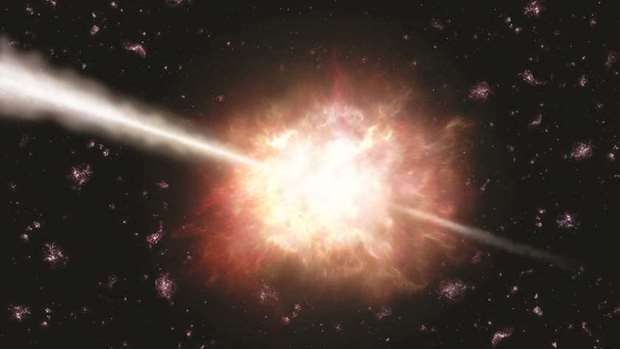Astronomers watching a fast-radio burst flashing from more than 3 billion light-years away say that its source lies in an extreme environment with a powerful magnetic field — perhaps a supermassive black hole, or the remains of a supernova.
The findings about the phenomenon known as FRB 121102, described in the journal Nature and at the American Astronomical Society meeting outside Washington, hint that this mysterious source of powerful radio waves whose origin has puzzled scientists for years may finally be revealing its secrets.
Since their discovery in 2007 from older archived data, fast-radio bursts have confounded astronomers. These bursts last only milliseconds, shorter than the blink of an eye, but in that tiny moment they are incredibly bright, a sign that whatever caused them was very powerful.
“It’s some sort of extreme physics that causes this emission and so the goal is to understand that,” study co-author Betsey Adams of ASTRON, the Netherlands Institute for Radio Astronomy, said at a briefing.
The problem is that these bursts each only happen once — leading scientists to suspect that these were cataclysmic, death-throe explosions. So even if a telescope is lucky enough to catch one in the act of going off, there no way to go back to the same source for more detailed measurements.
FRB 121102, sitting about 3 billion light-years away in a dwarf galaxy, was different. Since its discovery in 2012 it has repeatedly sent out flashes of radio waves, allowing researchers to train their telescopes on it to learn more about its origins.
“We know of thirty sources of fast radio bursts, and this is the only one we’ve ever seen that repeats,” senior author Jason Hessels, an astrophysicist at the University of Amsterdam and ASTRON, said in an interview.
Having now observed more than 100 flashes from this single source over the last few years, researchers haven’t picked up a pattern to the bursts yet — aside from the fact that they often seemed to be clustered in time, instead of evenly spaced apart.
Because of the extremely short, repeated bursts, the source was thought to be a kind of neutron star: either a pulsar (which spins very fast) or a magnetar (which spins but also has an extra strong magnetic field). Because it seems to sit in a star-forming region of its host galaxy, the scientists think FRB 121102 is linked to stellar birth or death.
For this paper, the scientists wanted to figure out more about the environment around this source. Using data from the Arecibo Observatory in Puerto Rico and the Green Bank Telescope in West Virginia, the scientists looked at the polarisation of the light: how much it’s been distorted in specific ways. They found that radio waves have been twisted by a magnetic field — an extremely powerful one, judging from the degree of contortion.
“We’ve seen this effect in other fast radio burst sources before, but in this case the effect is 500 times larger than what we’ve seen at other sources,” Hessels said. “That was quite surprising.”
These kinds of polarisation effects, he added, can be seen around powerful phenomena such as the supermassive black holes at the centre of galaxies. That makes some sense for FRB 121102, since the ionised gas, or plasma, around the black hole could be responsible for the magnetic field that’s twisting the neutron star’s signal.
The researchers think these repeated fast radio bursts are coming from a pulsar that happens to be sitting near a growing supermassive black hole that’s surrounded by gas and dust. But there are other possibilities: Perhaps a pulsar is interacting with the nebula from a dead star to create the strange repeat signal.
There are problems with both of those ideas, Hessel pointed out. If the neutron star’s radio signal is being twisted by the plasma around a nearby supermassive black hole, why would such a massive black hole exist in such a small dwarf galaxy? And if it’s being affected by a surrounding nebula, how did it get to be so bright?
Even the idea that the source itself is some kind of pulsar doesn’t explain why the bursts are so clumped. Spinning neutron stars have highly regular periods.
It could also be that plasma is acting as a sort of lens, focusing the radio light and allowing us to see it clearly. (In the black-hole scenario, the plasma could be both polarising and lensing the radio waves, Hessel said.) That could mean that the other fast radio bursts are also repeats, and we just haven’t had a proper space lens that would allow us to see more than one.
Whatever its source, whatever its environment, and whether or not it is similar to the other one-shot fast radio bursts, understanding FRB 121102 will help astronomers to better understand the universe we live in, Hessels said.
After all, even though only a few dozen individual sources in total have been found, researchers estimate that perhaps 10,000 fast radio bursts flash across the night sky every single day. And just as a flashlight on a dark night can illuminate all the dust and fog particles in its beam, each of these radio bursts can reveal a little more of the contents of the space between the source and us. — Los Angeles Times/TNS

STUNNING: Fast Radio Bursts, brief yet brilliant eruptions of cosmic radio waves, have baffled astronomers since they were first reported nearly a decade ago.
